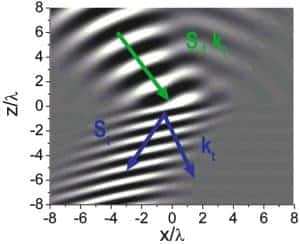US researchers have made a new kind of metamaterial that bends infrared light the "wrong" way. It was made by depositing alternating layers of semiconductor using a standard industrial process -- unlike most other negative index metamaterials (NIMs), which are slowly and painstakingly made from intricate metal structures. The team believes that the metamaterial could be used to shrink the size of today's unwieldy infrared optical systems, allowing them to be used in compact medical and enviromental sensors (Nature Materials doi:10.1038/nmat2033).

Negative-index metamaterials are artificial structures that are engineered to have a negative index of refraction. Light travelling through such a material is therefore bent in the opposite direction as light in a normal material – a property that could in principle be used to create “invisibility cloaks” and “superlenses”.
Most negative-index metamaterials are designed to have both a negative electrical permittivity and a negative magnetic permeability. However, for NIMs operating in the infrared, physicists have only been able to achieve this “double resonance” over very narrow ranges of wavelength. Other drawbacks of double-resonance NIMs are that they absorb much of the light passing through them and their intricate design makes it very difficult to make them thick enough to be of any practical use.
Now, Claire Gmachl and colleagues at Princeton University, Oregon State University and Alcatel-Lucent in New Jersey have created a different kind of NIM that does not rely on double resonance. Instead it has an electrical permittivity that is negative along only one direction in the metamaterial. This gives it a negative index of refraction over a broad range of wavelengths, and with little loss of light.
The metamaterial is made by depositing alternating layers of two semiconductors — indium gallium arsenide and aluminium indium arsenide — onto a substrate using molecular beam epitaxy. Each layer of the metamaterial is about 80 nm thick, which is much smaller than the wavelength of the infrared light.
When infrared light is shone into the material, its wavefront continues moving through in roughly the same direction. However the “Poynting vector” describing the energy flow of the light through the metamaterial is bent away from the direction of the wavefront (see Wrong way). This bending occurs because the permittivity is negative in the direction perpendicular to the layers and positive parallel to the layers.
Such a material could be a boon to those designing infrared optics, explains team member Anthony Hoffman of Princeton University: “Currently, the infrared lens is a massive object,” said Hoffman. “This new material may enable more compact mid-infrared optics because we have an entirely new set of optical parameters in our toolkit.” The team is now attempting to make a superlens from the NIM that could be used to obtain images of structures smaller than the wavelength of infrared light, which is impossible with a normal infrared lens.
John Pendry at Imperial College London, who is a pioneer of negative refraction, said of the work “They have found a way to make anisotropic materials to a high degree of perfection, and that’s quite remarkable.” he said. But he added that this material cannot be termed a negative-index metamaterial in the strictest sense. “Since it is not completely isotropic, its properties and hence the applications may be quite different from the metamaterials that have been built by other teams.”



